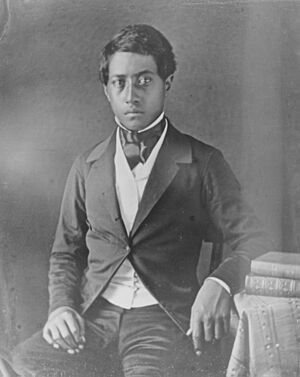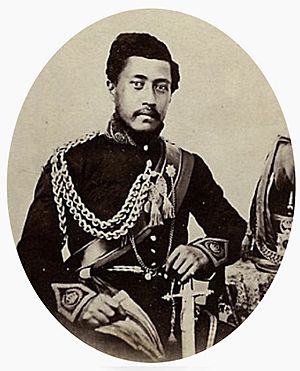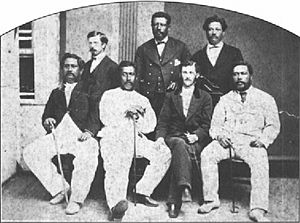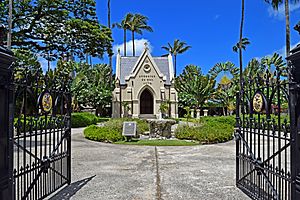Lunalilo facts for kids
Quick facts for kids Lunalilo |
|||||
|---|---|---|---|---|---|
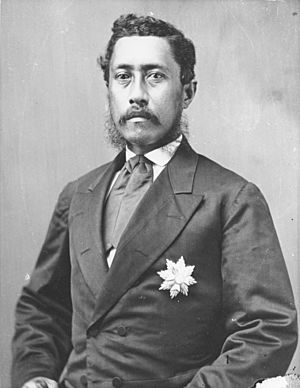
Photograph by Menzies Dickson
|
|||||
| King of the Hawaiian Islands (more...) | |||||
| Reign | January 8, 1873 – February 3, 1874 | ||||
| Investiture | January 9, 1873 Kawaiahaʻo Church |
||||
| Predecessor | Kamehameha V | ||||
| Successor | Kalākaua | ||||
| Born | January 31, 1835 Pohukaina, Honolulu, Oahu |
||||
| Died | February 3, 1874 (aged 39) Haimoeipo, Honolulu, Oahu |
||||
| Burial | February 28, 1874 Royal Mausoleum at Mauna ʻAla (temporary) November 23, 1875 Lunalilo Mausoleum, Kawaiahaʻo Church |
||||
|
|||||
| House | Keōua Nui / Kamehameha Kalaimamahu |
||||
| Father | Charles Kanaina | ||||
| Mother | Kekāuluohi | ||||
Lunalilo (William Charles Lunalilo; January 31, 1835 – February 3, 1874) was the sixth monarch of the Hawaiian Kingdom. He became king after being elected on January 8, 1873. He ruled for just over a year until his death.
Lunalilo was born to Kekāuluohi and High Chief Charles Kanaʻina. He was a grandnephew of King Kamehameha I. He went to the Royal School where American missionaries taught him. King Kamehameha III later said he could become king. After King Kamehameha V passed away, Lunalilo was chosen by the legislature in 1873. Everyone voted for him. People called him "The People's King" because he was so popular and was the first Hawaiian king to be elected. He died a year later from a sickness called tuberculosis.
Contents
Early Life of Lunalilo
William Charles Lunalilo was born on January 31, 1835. His birthplace was a coral brick house in an area called Pohukaina in Honolulu. Today, this area is part of the ʻIolani Palace grounds. His mother was High Chiefess Miriam Auhea Kekāuluohi. His father was High Chief Charles Kanaʻina.
Lunalilo was a grandnephew of Kamehameha I by blood. His grandmother, Kalākua Kaheiheimālie, was the sister of Queen Kaʻahumanu. This made him a cousin to King Kamehameha V and King Kamehameha IV. The name Lunalilo means "so high up as to be lost to sight" in the Hawaiian language. He was also named after King William IV of the United Kingdom. King William IV was a good friend of the Hawaiian royal family.
King Kamehameha III declared Lunalilo eligible to become king. He was sent to the Chief's Children's School. Missionaries Amos Starr Cooke and Juliette Montague Cooke started this school. Lunalilo learned to speak both Hawaiian and English. He loved English literature and Shakespeare's plays.
Before the Great Māhele, Lunalilo owned many lands. He had 239 ʻāina (land divisions), second only to Kamehameha III. After the Mahele, he gave up a lot of his land. By 1848, at age thirteen, he was still one of the biggest landowners. He inherited land from his mother and grandmother. In 1850, Lunalilo gave more land to the government.
People often called him "Prince Bill." He was one of the royal family members who wrote music. He wrote Hawaii's first national anthem, "E Ola Ke Aliʻi Ke Akua." This song was Hawaii's version of "God Save The King." He wrote it in just fifteen minutes for a contest in 1862. He won ten dollars.
Lunalilo served on the Privy Council of State. This council advised the king. He served from 1863 to 1865. He also served in the House of Nobles. This was the upper house of the legislature. It was usually for high chiefs. He was a member from 1863 to 1872.
Royal Marriage Plans
Lunalilo was supposed to marry his cousin, Princess Victoria Kamāmalu. Many Hawaiian people liked this idea. However, Victoria's brothers did not want them to marry. They worried that Lunalilo and Victoria's children would have a higher family rank than the House of Kamehameha. There were two attempts for them to marry, but they failed. Lunalilo wrote the Hawaiian song ʻAlekoki for his love for Victoria.
After Victoria, he briefly wanted to marry Liliʻuokalani. But she ended their engagement. She did this after King Kamehameha IV advised her. Liliʻuokalani later married John Owen Dominis. Victoria Kamāmalu never married and died at age 27.
During his time as king, some people suggested he marry Queen Emma. She was the widow of Kamehameha IV. But this marriage did not happen. Queen Emma was very devoted to her late husband. They remained good friends. It was said that Lunalilo thought about naming her as his heir before he died.
Becoming King: The Election
King Kamehameha V died on December 11, 1872. He was the last of the Kamehameha kings. He did not name anyone to take his place. The Kingdom's 1864 constitution said that if the king didn't choose an heir, the legislature would elect a new king. They would choose from the royal family members who were still alive.
The other main candidate was David Kalākaua. Lunalilo was much more popular. His grandfather was Kalaimamahu, a half-brother of Kamehameha I. This made Lunalilo a cousin of King Kamehameha V. Many people believed Lunalilo should be king. This was because Bernice Pauahi Bishop, who was more closely related to Kamehameha V, did not want the throne.
Another person considered was Princess Ruth Keʻelikōlani. She was a half-sister to King Kamehameha V. Many Hawaiian chiefs liked her because she followed old Hawaiian traditions. She was the governor of Hawaii. She refused to speak English, even though she knew it well. But her family background was too debated. Few people thought she was right for the throne.
This left Kalākaua and Lunalilo. Lunalilo was strongly favored. He was so popular that some thought he could just walk into the capital and declare himself king. But Lunalilo insisted that the constitution be followed. Six days after Kamehameha V died, Lunalilo sent a message:
"It is good that the Hawaiian people's wishes are asked about who should be the next King. Even though I am the rightful heir by law, I want to let the people decide. This will help keep peace and order."
Lunalilo wanted to change the constitution. He wanted to make the government more democratic. He wanted to remove rules about owning property to vote. It was decided there would be a popular election. This would let the people share their opinions. However, the constitution gave the legislature the power to choose the king. So, the popular vote would not be official. Lunalilo still encouraged people to vote.
The popular vote happened on January 1, 1873. Lunalilo won by a huge number of votes. A week later, the legislature voted Lunalilo king. Their vote was unanimous. Some people think this was because each legislator had to sign their ballot. They might have been afraid to go against what the people wanted. Queen Emma later wrote that many Hawaiians were ready to harm anyone who opposed Lunalilo.
Lunalilo's coronation ceremony was on January 9, 1873. It was held at Kawaiahaʻo Church. The church courtyard was full, and many people watched from outside. Because Lunalilo was so popular and became king through a democratic process, he was called "The People's King."
Lunalilo's Time as King
When Lunalilo became king, he started big changes in the government. The king before him, Kamehameha V, had tried to make the king's power stronger. He wanted to bring back the absolute monarchy of Kamehameha I. But Lunalilo wanted to make the Hawaiian government more democratic. He wrote to the legislature, suggesting changes to the constitution. He wanted to undo some things Kamehameha V had done in the 1864 Constitution.
For example, before 1864, the Kingdom legislature had two parts. These were the House of Nobles and the House of Representatives. The king chose members of the House of Nobles. People voted for the Representatives. Lunalilo had served in the House of Nobles. Under King Kamehameha V, the two houses were combined into one. Lunalilo wanted to bring back the two-house system. He also wanted a rule that the king had to explain any veto in writing. He wanted cabinet ministers to be heard in the House of Representatives.
The King also wanted to make Hawaii's economy better. The Kingdom was in an economic depression. The whaling industry was getting smaller. Business groups asked the king to focus on sugar to help the economy. They suggested a treaty with the United States. This treaty would let Hawaiian sugar enter the U.S. without taxes. To get this treaty, many thought Hawaii would need to offer the Pearl Harbor area to the United States. There was a lot of disagreement about this. Both the public and the legislature were against it. When Lunalilo saw this opposition, he stopped the idea.
During Lunalilo's rule, a mutiny happened in the small Hawaiian army. Some soldiers rebelled against their drillmaster. The king talked to the soldiers involved. He convinced them to put down their weapons. After this, the king ended the army. The Kingdom did not have armed forces again until King Kalākaua brought them back.
Sickness and Death
Around August 1873, Lunalilo caught a bad cold. It turned into pulmonary tuberculosis. He hoped to get better, so he moved to Kailua-Kona. A few months later, on February 3, 1874, he died from tuberculosis. He was 39 years old. He passed away at Haimoeipo, his home in Honolulu. Lunalilo had been king for one year and twenty-five days.
Before he died, he asked to be buried at Kawaiahaʻo Church. He wanted to be "entombed among (my) people." He did not want to be buried only with kings and chiefs at the Royal Mausoleum. So, on November 23, 1875, his body was moved. It was taken from the Mausoleum, where it had been temporarily. It went to his completed tomb at Kawaiahaʻo Church. His father asked for a second funeral. He also asked for a 21-gun salute, like at the first funeral. King Kalākaua allowed the second funeral but not the salute. During this procession, people said a sudden storm came. Twenty-one loud thunderclaps were heard across Honolulu. People called this the "21-gun salute."
Like the king before him, Lunalilo did not name an heir to the throne. It was said he wanted Queen Emma to be the next ruler. But he died before he could officially announce it. The main reason for this delay might be his belief in democracy. He wanted the people to choose their next ruler. However, the 1864 constitution said the legislature, not the people, should elect the next king. In the end, Kalākaua was voted to become the next king. This election caused some unrest. Supporters of Queen Emma were upset.
Lunalilo's Legacy
In his will, Lunalilo set aside land to create the Lunalilo Home. This was the first charitable trust started by a Hawaiian chief. It was meant to house poor, needy, and sick people of Hawaiian descent. Older people were given first choice.
See also
 In Spanish: Lunalilo para niños
In Spanish: Lunalilo para niños


